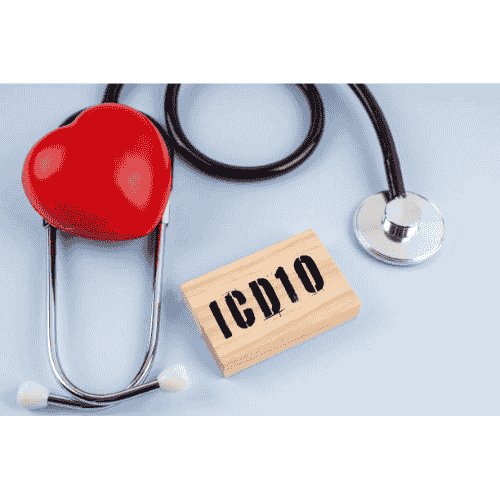Testosterone replacement therapy (TRT) has been the focus of men’s attention lately because more and more of them experience problems with the level of their testosterone. The ICD-10 codes used with TRT come in very handy both for providers and their patients. Such codes, through aestheticizing the billing process, are also a guarantee that the documentation and treatment plans are proper.
Truth be told, getting through the mazes of ICD-10 codes is somewhat akin to a choir of angels’ singing, but it is something you have to do to keep the lines of communication between you and your healthcare provider open and flowing. If you are thinking about TRT or are already under this treatment, then being familiar with the respective codes could broaden your awareness of the therapy and its implications on health. Let’s take a closer look at ICD-10 for testosterone replacement therapy and its effect on the treatment journey.
ICD 10 Overview
ICD-10 is a system of coding for diseases. For TRT, main codes used are E29.1 which indicate male hypogonadism. E34.9 denotes unspecified endocrine disorders. These codes help with billing and keeping records. Correct coding ensures reimbursement and tracking care.
TRT involves replacing testosterone in men. ICD-10 codes are vital for healthcare providers to document accurately. E29.1 indicates low testosterone production while E34.9 is used when the cause of hypogonadism isn’t clear.
Correct use of these codes facilitate claims to insurance companies. It also assists doctors in tracking patients’ progress in treatment. The knowledge of ICD-10 codes also makes the interaction between the provider and the patient more effective and the patient is empowered to understand the treatment plan and gain knowledge of specific therapies.
The process of implementing coding correctly is not very simple. For example, a patient who has been diagnosed with primary hypogonadism has E29.1 eventuated, while the patient with a secondary hypogonadism could have a different associated code if there are existing other conditions. The proper operation of the coding keeps on track the correct TRT interventions, according to the clinical guidelines, to meet the requirements of the patient.
An insightful application of ICD-10 to code the patient’s diagnosis also impacts the researchers’ area of interest in clinical practice and epidemiological studies. The research team documents the frequency and distribution of the conditions treated with TRT, and the indicators thus obtained help in making reflections of future treatment protocols and health policy decisions.
Becoming familiar with the specific coding issues of ICD-10 in the context of TRT is a source of strength for you and your healthcare provider. You, as a patient, will feel confident and be able to contribute to the decision-making process and facilitate the management of low testosterone levels in an effective way in collaboration with your healthcare provider.
Understanding Testosterone Replacement Therapy
Testosterone replacement therapy (TRT) is a way of treatment offered to males facing the problem of low testosterone levels. It is a must that one comprehends the good and the bad of the therapy before making an informed decision about something that directly affects their health.
Benefits of Testosterone Replacement Therapy
- Improved Energy Levels: TRT is often a solution to get higher energy and less fatigue, thereby boosting the overall vitality.
- Increased Muscle Mass: The Testosterone therapy program helps with muscle development and strength, thus physical fitness and athletic performance are well maintained.
- Enhanced Mood: The feelings of joy and less symptoms like depression and anxiety are occurring so that emotional wellness is being facilitated in quite a number of people.
- Better Sex Drive: The presence of TRT usually goes hand in hand with the presence of a higher libido hence better relations among the intimate.
- Cognitive Improvement: A number of researches show that TRT may be related to increased cognitive function and memory retention.
- Bone Health: TRT helps men to not only keep their bones in good condition but even improve their bone density, thus preventing both osteoporosis and fractures.
Being the benefits of testosterone replacement therapy to be so significant, even in those with low testosterone, this will enable you to live a more fulfilling life by being more active in the day.
Risks and Considerations
- Cardiovascular Concerns: Testosterone replacement therapy may significantly increase the chances of heart problems such as heart attacks and stroke, especially in older men who are more inclined to be at such risks.
- Sleep Apnea: Some patients display not only exacerbation of sleep apnea symptoms but also its first-time development, therefore, such a condition is to be evaluated and monitored concerning sleep patterns.
- Skin Reactions: The epidermal impacts of applying testosterone-related medications might include a range of issues like from common skin irritations to allergic reactions at the application site.
- Prostate Health: TRT is more likely to lead to the enlargement of the prostate tissue, which is of great concern to men with previous prostate issues.
- Hormonal Imbalance: An increase in the level of testosterone which exceeds the natural norm can result in adverse effects such as acne or emotional problems.
- Infertility: TRT not only can, but does, lower the production of natural testosterone, thereby lowering a man’s fertility especially in the young group.
Having an awareness of these dangers enables you to make informed decisions about taking TRT and to be ready for constant control and medical counseling throughout the treatment.
ICD 10 Codes for Testosterone Replacement Therapy
Knowing the ICD-10 codes for testosterone replacement therapy (TRT) is necessary for the correct billing and successful treatment. Here is a list of the main codes and the corresponding symptoms required for the administration of TRT.
Relevant Codes and Descriptions
| ICD-10 Code | Description |
| E29.1 | Testosterone deficiency (male hypogonadism) |
| E34.9 | Other endocrine disorders |
| N46 | Male infertility |
| E31.3 | Mixed connective tissue disease |
The main code E29.1 deals with testosterone deficiency and can be used to describe the case of a lack of the hormone causing health damage. E34.9 the second code is more of general endocrine disorders, which may not be directly linked to testosterone but, nonetheless, result in symptoms. N46 refers to male infertility and mainly highlights low testosterone with no sperm production. E31.3 mentions mixed connective tissue disease, where symptoms may be hormonal but technically affect overall health.
Diagnosis Criteria
The diagnosis of testosterone deficiency typically involves the provision of clinical and laboratory evidence, i.e., a combination of both. Several symptoms such as decreased libido, fatigue, muscle loss, mood swings, etc. should be reported, and the patient’s serum testosterone level should be below the reference range by the blood test T-values<300 ng/dL being a sign of subnormality. The
Other relevant factors apart from this could be the patient’s age, with testosterone levels that are naturally low due to old age, and health issues such as high body concentration of fat or diabetes. An in-depth evaluation carried out by the doctor helps reach an accurate diagnosis, proper coding, and adequate planning of treatment. As well-known health physicians who offer these wide-ranging services not only give the patients full health attention but also know who to charge and for how much.
Treatment Protocols and Guidelines
Testosterone replacement therapy (TRT) carefully concerns its treatment protocols and guidelines compliant with both quality and safety. This protocol contains the complete outline of topics from the patient’s assessment to the dose finding, monitoring, and therapy capsulization.
- Initial Assessment:
Carry out a comprehensive clinical assessment, which should consist of a patients’ history and an in-depth physical examination.
Conduct a blood test to measure the testosterone in the body, generally not later than in the morning, to ensure that the sample does not have too much interference. Confirm the levels of low testosterone at least twice, especially if the patient is willing to accept the diagnosis for a reliable diagnosis.
- Dosage Determination:
Choose the best method for therapy and begin your treatment (injections, patches, or gels).
The usual starting dosages are 50-200 mg per week for injections, and the transdermal patches provide 1% or 1.62% testosterone, respectively.
- Monitoring Response:
How the patient has responded and the testosterone levels are checked after 3 to 6 months of the therapy. It is checked by confirming the right levels (300 to 1,000 ng/dL) of the blood test.
If the initial reaction of the therapy, side effects or the presence of unwanted reactions by the patient, such as the dosage needed to be increased, were taken into account.
- Follow-Up Care:
Get the examination of the testosterone and control the side effects such as those to the cardiovascular, prostate, and the levels of hemoglobin that may occur at regular intervals of 6-12 months.
Make necessary changes to the treatment based on the conclusions and patient feedback.
- Patient Education:
Let patients know about the advantages and disadvantages of TRT, with a strong emphasis on the significance of following the treatment plan and regular examinations to the patients.
Explain the changes in the style of the patient and their impact on the treatment outcomes that can include weight loss, exercise, and diet alteration.
Healthcare providers can optimize TRT for you, thus rebalancing the androgen level to a healthy status, and reducing the undesired effects by strict adherence to these protocols and regulations.
Conclusion
To navigate the complexities of the testosterone replacement therapy and its related ICD-10 codes is highly recommended, so that for the patients and the healthcare provider it will be the best option. By learning the names and exact codes, one can ensure the correct billing of a diagnostics test and treatment planning would be efficient, thus no longer a one-man show.
Moreover, as you decide to go through TRT, there is a need to ponder the pluses and minuses of this therapy. Furthermore, it is through regular observation and honest talks with your provider that you will be better placed to make decisions that are in line with your health status. Developing such a model will not only lead to the greatest transformative consistency but will also serve as the best.low testosterone levels effectively.
Frequent Ask Questions
What is testosterone replacement therapy (TRT)?
TRT is a medical treatment that is the male’s remedy to the lack of testosterone, which is mostly accompanied by sexual issues like andropause. The methods used for testosterone restoration in this process include the hormone by injections, gels, and even implants as long as the hormonal balance is brought back to the state where the symptoms of the lower energy were the ones that prevailed the moods reduced sexual lust were the major symptoms.
Why are ICD-10 codes important for TRT?
These codes are the lifelines for so many healthcare matters such as billing, documentation, and treatment planning. In relation to their usage, documentation of health records, and patient accounts is made good through them, they encourage patient and healthcare provider communication on diagnosis and treatment strategy for TRT.
What ICD-10 codes are related to testosterone deficiency?
The main ICD-10 code representing testosterone deficiency is E29.1 which stands for male hypogonadism. The other codes that are also relevant to the situation are E34.9, specifying other endocrine disorders, and N46, pointing out male infertility as other related conditions.
What are the benefits of TRT?
Testosterone replacement therapy upgrades the patients with energy gain, resulting in an uplifted mood, mind sharpness, sensual desires increased, muscle mass is strengthened, and bone health flourished. These benefits, without any doubt, increase the quality of life amp; wellbeing of the patients.
How is testosterone deficiency diagnosed?
The usual procedure for diagnosing androgen deficiency is to carry out a clinical examination, and at the same time, blood tests are done to check the level of hormones. Symptoms such as lack of energy and libido may lead to the clinician that they should go for other tests and give an accurate diagnosis.
What treatment protocols should be followed for TRT?
For TRT, it is advisable that the patient undergoes an assessment at the beginning of the treatment, then through the same line of a clinical evaluation and laboratory tests, dosage determination with attention, and the last phase comes when the patient’s responses. In this way, regular follow-ups provide safe and effective therapy and also health care.






